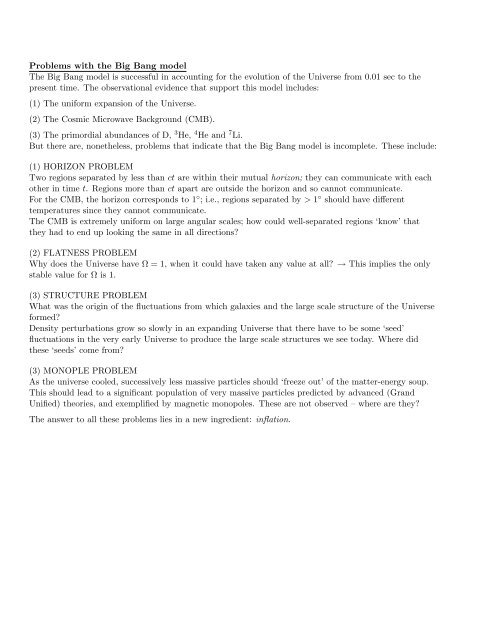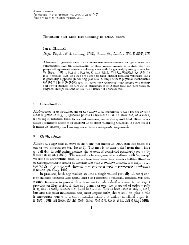Lecture Notes â Cosmology - UCL Astronomy Group
Lecture Notes â Cosmology - UCL Astronomy Group
Lecture Notes â Cosmology - UCL Astronomy Group
Create successful ePaper yourself
Turn your PDF publications into a flip-book with our unique Google optimized e-Paper software.
Problems with the Big Bang model<br />
The Big Bang model is successful in accounting for the evolution of the Universe from 0.01 sec to the<br />
present time. The observational evidence that support this model includes:<br />
(1) The uniform expansion of the Universe.<br />
(2) The Cosmic Microwave Background (CMB).<br />
(3) The primordial abundances of D, 3 He, 4 He and 7 Li.<br />
But there are, nonetheless, problems that indicate that the Big Bang model is incomplete. These include:<br />
(1) HORIZON PROBLEM<br />
Two regions separated by less than ct are within their mutual horizon; they can communicate with each<br />
other in time t. Regions more than ct apart are outside the horizon and so cannot communicate.<br />
For the CMB, the horizon corresponds to 1 ◦ ; i.e., regions separated by > 1 ◦ should have different<br />
temperatures since they cannot communicate.<br />
The CMB is extremely uniform on large angular scales; how could well-separated regions ‘know’ that<br />
they had to end up looking the same in all directions<br />
(2) FLATNESS PROBLEM<br />
Why does the Universe have Ω = 1, when it could have taken any value at all → This implies the only<br />
stable value for Ω is 1.<br />
(3) STRUCTURE PROBLEM<br />
What was the origin of the fluctuations from which galaxies and the large scale structure of the Universe<br />
formed<br />
Density perturbations grow so slowly in an expanding Universe that there have to be some ‘seed’<br />
fluctuations in the very early Universe to produce the large scale structures we see today. Where did<br />
these ‘seeds’ come from<br />
(3) MONOPLE PROBLEM<br />
As the universe cooled, successively less massive particles should ‘freeze out’ of the matter-energy soup.<br />
This should lead to a significant population of very massive particles predicted by advanced (Grand<br />
Unified) theories, and exemplified by magnetic monopoles. These are not observed – where are they<br />
The answer to all these problems lies in a new ingredient: inflation.











